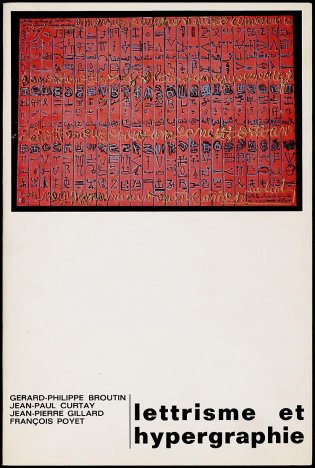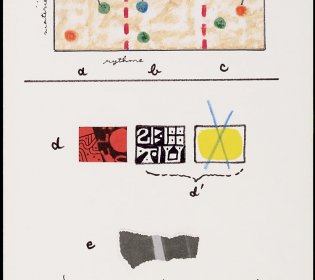Lettrisme et hypergraphie
Year: 1972
Author: Gérard-Philippe Broutin (*1948)
Artists: J.-B. Arkitu (*1954), Roland Sabatier (1942 - 2022), Myriam Darrell (*1944) and others
Publisher: Fall
The seduction of the strange
Strange words or characters – whether they are ancient runes or Chinese, Arabic, or Russian characters – have always held an immense attraction to our minds. That is also the power of 'lettrisme' and the fascinating and original creations produced by the 'lettristes'. They seduce us with the strange, which is often reminiscent of Arabic calligraphy, Egyptian hieroglyphs, tattoos, or contemporary graffiti. The authentic paintings by Arkitu, Canal, Sabatier, and Darrell clearly illustrate this.
Four 'lettristes': Arkitu, Canal, Sabatier, Darrell
J.-B. Arkitu, who joined the 'groupe lettriste' in May 1968, was initially guided by the first technical rule of 'lettrisme': the amplic phase ('phase amplique'), in which every possible stylistic combination of printed text is explored. He later devoted himself to 'hypergraphie', developing a highly personal style within this field.
Arkitu's explorations of hand-written letters are innovative and original; they are no longer recognizable, and this gives them an entirely unique value and power of expression.
The style of Françoise Canal (1944) was initially playful and intuitive, and seemed to move in all directions at once with its multitude of signs and symbols. This later changed into specific, well-considered, and modest compositions. Her contribution to this edition is one of them, in spite of the bright pink gouache.
The thoroughbred 'lettriste' Roland Sabatier (1942) devoted himself to the theatre, film, and photography, combining lettrism with hypergraphy, collage, and science. He published a 'roman hypergraphique', also producing a variation on Man Ray's 'rayographies'. Sabatier was the one who dubbed them 'rayogrammes', in which not the objects but the handwriting and letters left their imprint on photo paper during the development process. In his contribution to Lettrisme et hypergraphie, collage, hypergraphy and science are brought together.


